- GCN/BACODINE POSITION NOTICE
TITLE: GCN/SWIFT NOTICE
NOTICE_DATE: Thu 14 Jul 05 22:41:50 UT
NOTICE_TYPE: Swift-BAT GRB Position
TRIGGER_NUM: 145994, Seg_Num: 0
GRB_RA: 169.694d {+11h 18m 47s} (J2000),
169.763d {+11h 19m 03s} (current),
169.068d {+11h 16m 16s} (1950)
GRB_DEC: -15.528d {-15d 31' 39"} (J2000),
-15.558d {-15d 33' 28"} (current),
-15.254d {-15d 15' 14"} (1950)
GRB_ERROR: 4.00 [arcmin radius, statistical only]
GRB_INTEN: 0 [cnts] Image_Peak=1629 [image_cnts]
TRIGGER_DUR: 64.000 [sec]
TRIGGER_INDEX: 20000 E_range: 15-50 keV
BKG_INTEN: 0 [cnts]
BKG_TIME: 0.00 SOD {00:00:00.00} UT
BKG_DUR: 0 [sec]
GRB_DATE: 13565 TJD; 195 DOY; 05/07/14
GRB_TIME: 81632.37 SOD {22:40:32.37} UT
GRB_PHI: -171.46 [deg]
GRB_THETA: 46.35 [deg]
SOLN_STATUS: 0x13
RATE_SIGNIF: 0.00 [sigma]
IMAGE_SIGNIF: 10.07 [sigma]
MERIT_PARAMS: +1 +0 +0 +6 +1 +0 +0 +0 -41 +1
SUN_POSTN: 114.37d {+07h 37m 29s} +21.55d {+21d 32' 56"}
SUN_DIST: 65.77 [deg]
MOON_POSTN: 203.84d {+13h 35m 22s} -10.84d {-10d 50' 06"}
MOON_DIST: 33.48 [deg]
MOON_ILLUM: 53 [%]
GAL_COORDS: 272.38, 41.78 [deg] galactic lon,lat of the burst (or transient)
ECL_COORDS: 176.88,-18.31 [deg] ecliptic lon,lat of the burst (or transient)
COMMENTS: SWIFT-BAT GRB Coordinates.
COMMENTS: This is an image trigger. (The RATE_SIGNIF & BKG_{INTEN, TIME, DUR} are undefined.)
COMMENTS: A point_source was found.
COMMENTS: This does not match any source in the on-board catalog.
COMMENTS: This does not match any source in the ground catalog.
COMMENTS: This is a GRB.
- red DSS finding chart
ps-file
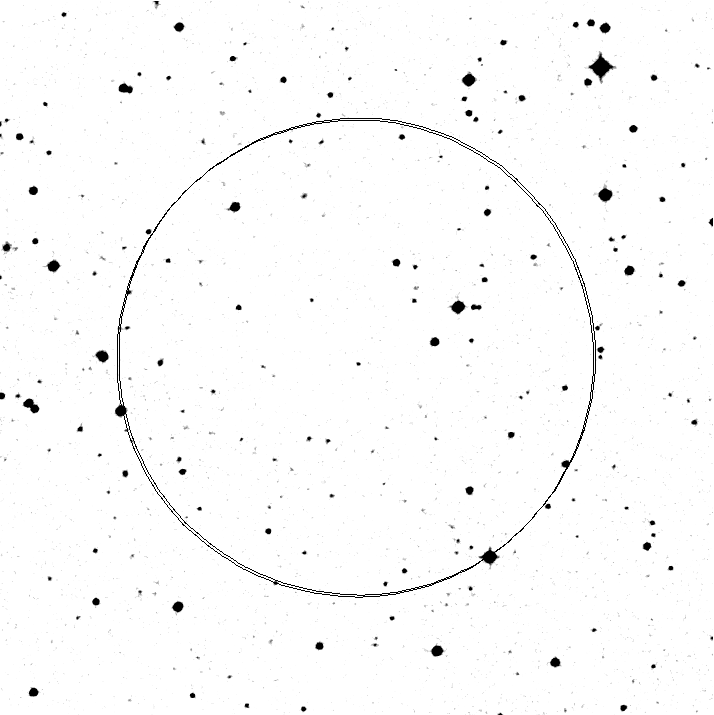
- GCN/SWIFT NOTICE
TITLE: GCN/SWIFT NOTICE
NOTICE_DATE: Thu 14 Jul 05 22:45:01 UT
NOTICE_TYPE: Swift-BAT GRB Lightcurve
TRIGGER_NUM: 145994, Seg_Num: 0
GRB_RA: 169.694d {+11h 18m 47s} (J2000),
169.763d {+11h 19m 03s} (current),
169.068d {+11h 16m 16s} (1950)
GRB_DEC: -15.528d {-15d 31' 39"} (J2000),
-15.558d {-15d 33' 28"} (current),
-15.254d {-15d 15' 14"} (1950)
GRB_DATE: 13565 TJD; 195 DOY; 05/07/14
GRB_TIME: 81632.37 SOD {22:40:32.37} UT
TRIGGER_INDEX: 20000
GRB_PHI: -171.46 [deg]
GRB_THETA: 46.35 [deg]
DELTA_TIME: 0.00 [sec]
LC_URL: sw00145994000msb.lc
SUN_POSTN: 114.37d {+07h 37m 29s} +21.55d {+21d 32' 56"}
SUN_DIST: 65.77 [deg]
MOON_POSTN: 203.84d {+13h 35m 22s} -10.84d {-10d 50' 06"}
MOON_DIST: 33.48 [deg]
MOON_ILLUM: 53 [%]
GAL_COORDS: 272.38, 41.78 [deg] galactic lon,lat of the pointing direction
ECL_COORDS: 176.88,-18.31 [deg] ecliptic lon,lat of the pointing direction
COMMENTS: SWIFT-BAT GRB Lightcurve.
COMMENTS:
COMMENTS: The next comments were copied from the BAT_POS Notice:
COMMENTS: This is an image trigger.
COMMENTS: A point_source was found.
COMMENTS: This does not match any source in the on-board catalog.
COMMENTS: This does not match any source in the ground catalog.
COMMENTS: This is a GRB.
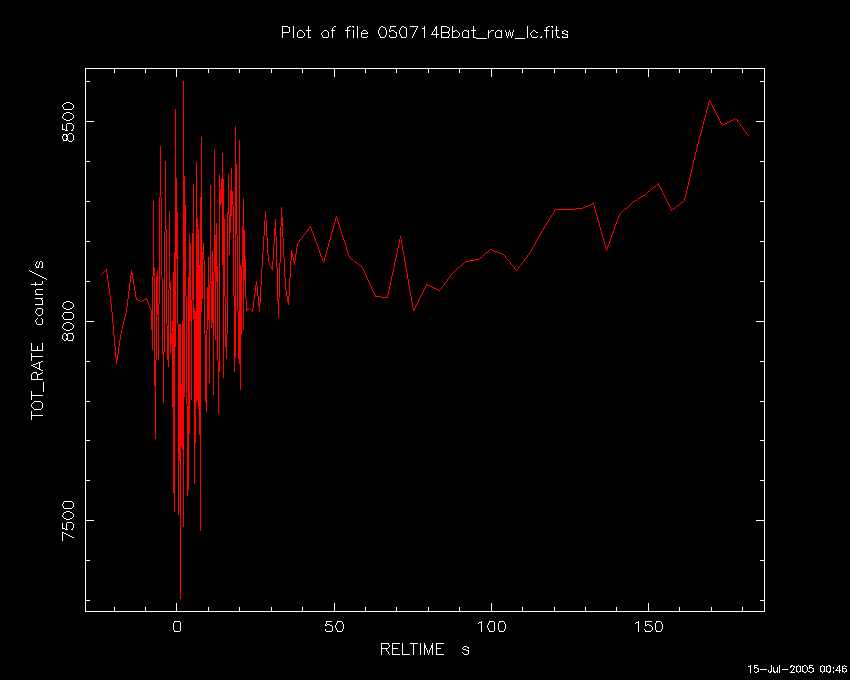
- GCN notice #3613
A. Levan, A. Beardmore, K. Page, J. Osborne, E. Rol (U. Leicester)
S. Barthelmy, J. Cannizzo (GSFC-UMBC), L. Cominsky (Sonoma State U.),
H. Krimm (GSFC), C. Markwardt (GSFC/UMD), D. Palmer (LANL), T. Sakamoto
(GSFC), C. Gronwall, D. Burrows, P. Roming, J. Kennea (PSU) and N. Gehrels
(GSFC) report for the Swift team.
At 22:40:32 UT, Swift-BAT triggered (trigger=145994) and located on-board
a source. The flight-determined location is RA,Dec 169.694, -15.528 {+11h
18m 47s, -15d 31' 39"} (J2000) with an uncertainty of 3 arcmin (radius,
90% containment, stat+sys). The spacecraft was on target at approximately
150 seconds. This was a very weak 64-sec image-trigger detection right at
the image-trigger threshold (10.1 sigma). There are no "peaks" in the BAT
lightcurve, which is consistent with a long low-amplitude event, and that
it was an image trigger and not a rate trigger. At this early stage in the
analysis, we can not distinguish between a long GRB and a hard X-ray
transient. However, we do think that it is from a real astrophysical
source.
The spacecraft slewed immediately and the XRT began observing the burst
at 22:43:00.6 UT (151 s after the BAT trigger). XRT found a
bright, uncatalogued, fading X-ray source. The position, calculated with
xrtcentroid on the TDRSS postage stamp image, is:
RA: 11h 18m 47.9s (J2000),
Dec: -15d 32' 55.5" (J2000).
This position is 76.5 arcseconds from the BAT position. The estimated
uncertainty is 6 arcseconds radius (90% containment).
The Swift Ultra Violet/Optical Telescope (UVOT) observations began at
22:43:03 UT, 151 seconds after the BAT trigger. The first data taken after
the spacecraft settled was a 100 seconds exposure using the V filter with
the midpoint of the observation at 201 seconds after the BAT trigger.
There is no new source at the XRT position.
- GCN notice #3614
D. Malesani (SISSA/ISAS), P. D'Avanzo (INAF, OABr), G.L. Israel, S.
Piranomonte (INAF, OARm), G. Chincarini (Univ Milano-Bicocca), L. Stella
(INAF, OARm), G. Tagliaferri (INAF, OABr), E. Depagne (ESO), report:
We observed the field of GRB 050714B with the ESO VLT-UT2 (Kueyen)
equipped with the FORS1 instrument. The observing conditions were
moderate, with a seeing of ~1.4 arcsec. Exposures were carried out in
the R band, starting on 2005 Jul 14, 23:37 UT (56 min after the GRB).
Inspection of the XRT error circle (Levan et al., GCN 3613) shows a
bright, single object not visible in the DSS at the approximate
coordinates (error ~1"):
alpha(J2000) = 11:18:47.8
delta(J2000) = -15:32:52.6
Its magnitude is brighter than the DSS limit, so we suggest that this
object is the afterglow of GRB 050174B.
This message can be cited.
- GCN notice #3615
J. Tueller (GSFC), S. Barthelmy, L. Barbier (GSFC), J. Cummings (GSFC/NRC),
E. Fenimore (LANL), N. Gehrels (GSFC), D. Hullinger (GSFC/UMD),
H. Krimm (GSFC/USRA), C. Markwardt (NASA GSFC/UMD), D. Palmer (LANL),
A. Parsons (GSFC), T. Sakamoto (GSFC/NRC),
on behalf of the Swift-BAT team:
Using the full data set from the recent telemetry downlink, we report
further analysis of Swift-BAT Trigger #145994 (Levan, et al., GCN 3613).
The ground-analysis position is RA,Dec 169.697,-15.535 (J2000).
The event-by-event data yields a lightcurve with a broad bump
starting at T+15 sec and ending at T+70 sec.
The spectrum over the interval from T-19 to T+68 seconds is soft.
The simple power law photon index is 2.6 +/- 0.3 with a fluence
of 6.5 +/- 1.4 X 10^-7 erg/cm^2 in the 15-350 keV band (90% c.l.).
The peak flux in a 1-sec wide window starting at T+55 seconds
is 0.5 +/- 0.2 ph/cm^2/sec.
Although we can not rule out a hard x-ray transient source,
it is more likely a real GRB, albeit on the soft end of the distribution.
- GCN notice #3616
S. Covino, P. D'Avanzo (INAF, OABr), D. Malesani (SISSA/ISAS), G.L. Israel, S. Piranomonte (INAF, OARm), G. Tagliaferri (INAF, OABr), G. Chincarini (Univ Milano-Bicocca), L. Stella (INAF, OARm), report:
Photometric analysis of our set of images of GRB 050714B (Levan et al., GCN 2613; Tueller et al., GCN 3615) taken with the VLT-FORS1 in the R band does not confirm the proposed identification of the object reported by Malesani et al. (GCN 3614) as the candidate optical afterglow.
The object shows constant brightness between Jul 14.984 UT and Jul 15.040 UT (from 56 to 137 minutes after the GRB, respectively) at about R = 21.7, taking as reference the USNO star U0675-11455984 with magnitude R = 15.3. A light curve for this object can be seen at the following URL:
http://www.sissa.it/~malesani/GRB/050714B/candidate_lc.gif
We give below the refined coordinates for the candidate, adopting an astrometric solution based on the 2MASS catalog:
alpha(J2000) = 11:18:47.71, delta(J2000) = -15:32:51.6
The error is 0.2 arcsec.
We note that two fainter objects are present close to the edge of the XRT error circle
A: alpha(J2000) = 11:18:47.71, delta(J2000) = -15:33:00.9
B: alpha(J2000) = 11:18:48.19, delta(J2000) = -15:32:50.3
None of such objects is seen to vary by more than ~0.1 mag.
A finding chart can be found here:
http://www.sissa.it/~malesani/GRB/050714B/GRB050714B_finder.jpg
This message may be cited.
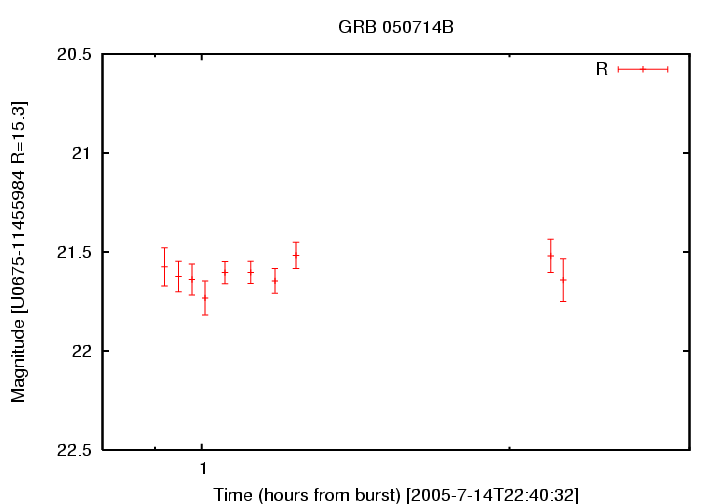
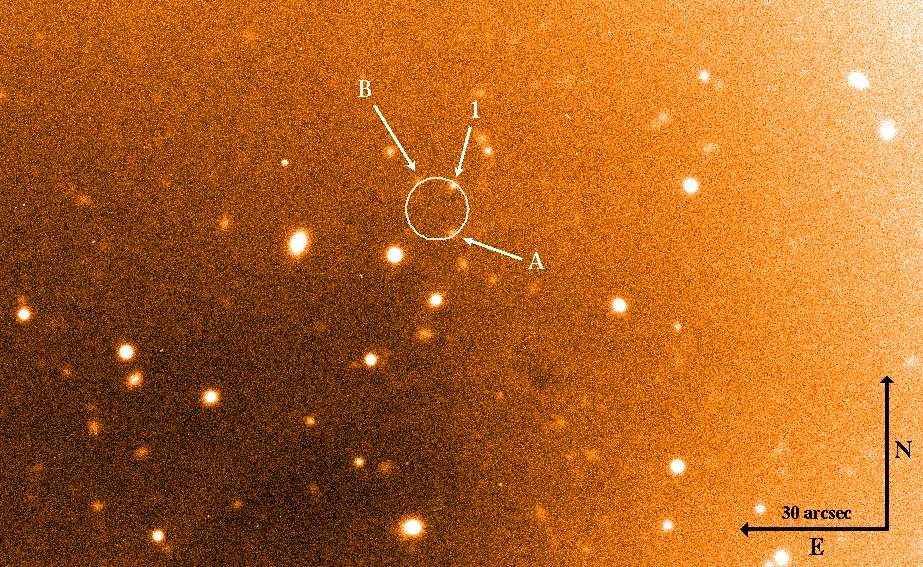
- GCN notice #3618
K. Page, A. Beardmore, A. Levan, E. Rol, J.P. Osborne (U. Leicester),
D. Morris, D. Burrows (PSU), A. Smale (NASA HQ), L. Cominsky (Sonoma
State U.) and N. Gehrels (GSFC) report for the Swift XRT team:
We have analysed the XRT data for GRB 050714B taken 157-18700
seconds after the trigger. PSF fitting of the candidate afterglow in the
photon counting (PC) mode observations yields a refined position of
RA: 11h 18m 48.0s (J2000)
Dec:-15d 32m 49.9s (J2000)
with an uncertainty of 6 arcseconds (90%). This position is offset
approximately 5.5 arcseconds from the position reported in GCN 3613
and does not contain object "A" found by Covino et al (GCN 3616).
XRT observations began in Windowed Timing (WT) mode 157 seconds after the
trigger and show a steep decline with a power-law decay index between 5
and 6, lasting for approximately 300 seconds. This is followed by a rise,
which peaks 400 seconds after the trigger and was recorded in PC
mode. No observations were performed between 546 and 5000 seconds. In
the interval 5000-18700 seconds a shallower decay of approximately 0.7
was seen. The behaviour is similar to that which has been seen in many
Swift afterglows and indicates that this transient is, most likely, a
GRB.
The spectrum of the early afterglow is exceptionally soft, having a photon
index of ~ 6, with evidence of spectral evolution between the WT and PC
mode observations. The mean unabsorbed fluxes in WT mode (157-220 seconds)
and PC mode (221-546 seconds) are 3.4e-9 and 1.7e-9 ergs/s/cm^2
respectively, in the 0.5-10 keV range. We note, however, that no
flux was detected above 2 keV by the XRT.
- GCN notice #3620
C. Gronwall, A. Morgan, P. Roming (PSU),
A. Levan (U. Leicester), M. Ajello (MPE),
M. Trippico (GSFC-SSAI), N. Gehrels (GSFC)
report on behalf of the Swift UVOT team:
We have analyzed the UVOT data for GRB 050714B
(Levan et al., GCN 3613; Tueller et al., GCN 3615)
taken 195 to 41743 seconds (approximately 12 hours)
after the trigger. We detect a faint extended source
in a summed ultraviolet image with a total exposure time
of 8936 seconds located at RA = 11:18:48.26, Dec = -15.:32:50.87.
This location is within the refined XRT error circle reported
by Page et al. (GCN 3618). At this time, we cannot determine
if this source is fading. We note that this source position is
consistent with the position of one of the faint sources
(source B) detected in the VLT-FORS1 R-band observations
reported by Covino et al. (GCN 3616).
- GCN notice #3644
P. D'Avanzo, S. Covino (INAF, OABr), G.L. Israel, S. Piranomonte (INAF,
OARm), D. Malesani (SISSA/ISAS), G. Tagliaferri (INAF, OABr), G.
Chincarini (Univ Milano-Bicocca), L. Stella (INAF, OARm), report:
The field of GRB 050714B (Levan et al., GCN 2613; Tueller et al., GCN
3615) was observed again with the ESO VLT-UT2. Ten exposures lasting 180
s were acquired with the FORS1 instrument (mean time 2005 Jul 17.97,
that is 3.03 days after the GRB). These images go deeper than our
previous dataset (Covino et al., GCN 3616).
In addition to sources 1 and B reported by Covino et al. (GCN 3616), we
find two more fainter sources lying at the edge of the XRT error circle
(Levan et al., GCN 3614; Page et al., GCN 3618):
C: alpha = 11:18:48.24, delta = -15:32:54.3 (J2000);
D: alpha = 11:18:48.40, delta = -15:32:53.3 (J2000).
An updated finding chart is posted at the following URL:
http://www.sissa.it/~malesani/GRB/050714B/finder_epoch2.jpg
When compared to our previous images, sources 1 and B do not show
variability within the photometric errors. Source B is coincident with
the UVOT object (Gronwall et al., GCN 3620) and is extended also in our
images.
At the present stage, therefore, no object can be easily singled out as
the GRB afterglow, although source B could be the GRB host galaxy.
We thank the ESO staff for excellently performing these observations in
service mode.
This message may be cited.
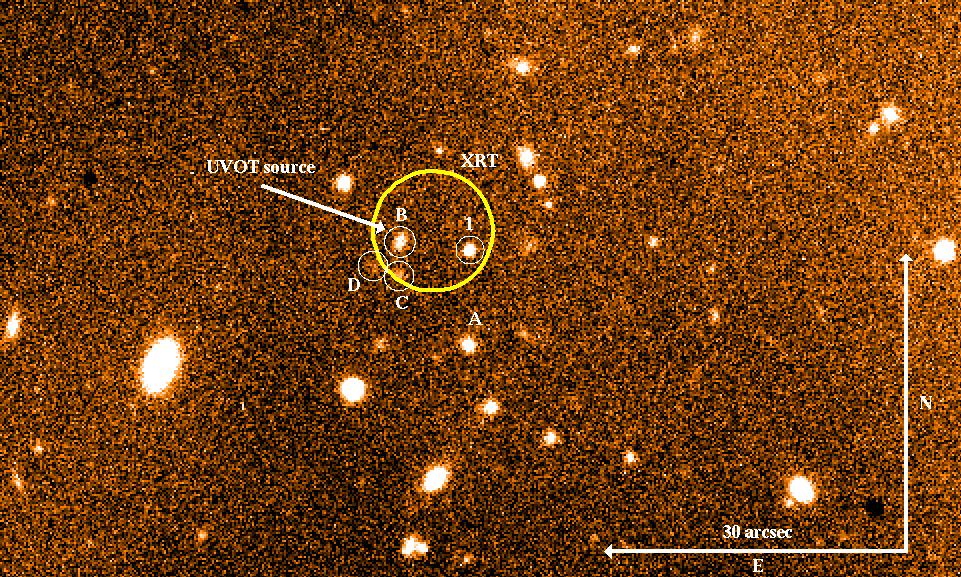
- GCN notice #3651
P. B. Cameron reports on behalf of the Caltech-NRAO-Carnegie
collaboration:
"We observed the field of GRB050714b (GCN 3613) with the Very Large Array
at 8.5 GHz on July 19.98. No radio source is detected within the XRT error
circle (GCN 3618) with a 2-sigma upper limit of 102 uJy.
The National Radio Astronomy Observatory is a facility of the National
Science Foundation operated under cooperative agreement by Associated
Universities, Inc."
- arXiv:1505.06743
X-shooter redshift: 2.4383
![]() Previous IAU Circulars
Previous IAU Circulars 



